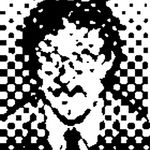- Home
- Illustrator
- Discussions
- Re: Problem with exporting files to 300dpi PNG, it...
- Re: Problem with exporting files to 300dpi PNG, it...
Copy link to clipboard
Copied
Hello everyone.
I hope you can help me out. I've never had any problems with Illustrator until now. I created a pattern, and now I need to export it to upload it to a print-on-demand website. Until now, I always exported a 5000x5000px PNG image, and everything went fine. But not today. When I tried to export the file, unfortunately, I ended up with an annoying rectangle in the middle of my image that, as you can see from the screenshot, is not present in the Illustrator file. I haven't changed anything in my export process or my export template. What can I do to solve this problem? I've already updated Illustrator to the latest version, restarted my Mac, created a new file with the necessary dimensions, and tried to bring the pattern back in. I've also checked the pattern file, but everything seems correct. Has this happened to anyone else? What can I do to solve this issue?
Thank you in advance to anyone who can help me.
Have a great day.
The illustrator file screenshot.
The exported file screenshot.
 1 Correct answer
1 Correct answer
Esse.Effe,
The math here is actually only brought into this by the 300 dpi (which is really a print term d for Dots, rather than a screen/web term P for Pixels in PPI). For my own part, I am (almost) always just seeing things and drawing them, leaving the math to Illy (job description Adobe Illustrator) and she is very good at it, also far beyond usual uses.
In addition to what Test Screen Name said, the following short and rather mathless exposition may sound unforgivably outdated and bor
...Explore related tutorials & articles
Copy link to clipboard
Copied
What type of print process are they using? PNG sounds all wrong for this. PNG is meant for for transparency, RGB. Print is CMYK, you can probably upload as a .pdf (use a CMYK preset like PDF-X or Pnint Ready ) instead for maximum quality, and small file size
Copy link to clipboard
Copied
I suspect this is happening as PNG is never meant for high resolution and this was not tested enough by Adobe. Maybe you are doing a rare Giclee print which is RGB used for print. I would try saving as .psd then, and in Photoshop converting to .png.
Best way for us to help you is to first get you on the correct file format, and then troubleshoot the missing art. If the printer sent you specs, or has a website please share.
Copy link to clipboard
Copied
I am not a professional, I still have a lot to learn. Thank you for the answers.
Regarding my issue, I first went to check the specs. I would like to upload my graphics to multiple sites (zazzle, society6, and spoonflower) without having to export the same graphic in a thousand different formats.
All three accept JPG or PNG, but only zazzle also accepts PDF. That's why I had ruled it out this file format.
All three require the file to be in RGB. I realized from your responses that I had made the wrong choice when creating the new file. However, I immediately corrected it and set RGB for the file created for export. After this modification, I tested it and exported the file again, and this time it worked fine. The file no longer has that rectangle in the middle of the image. I also tried exporting the file in JPG format, but Illustrator gave me an error, saying that it was impossible to export the file and to set a lower resolution and try again.
I also tried exporting the file in PDF format and here is the screenshot.
There seem to be some glitches/missing parts (the center of some flowers) when opening the file, but they disappear when zooming in. I also uploaded the PDF file to zazzle, and everything seems okay on the website.
Do you think the problem was that I accidentally chose CMYK instead of RGB?
Copy link to clipboard
Copied
Are you trying to export a single pattern tile? And at what resolution or just a fixed 5000 px?
Edit: I saw the 300 dpi, that would result in a 1,21 gigabyte file.
Copy link to clipboard
Copied
What I want to export is a rectangle with my pattern inside (I created the pattern tile in a separate file with all my color variations choices). Hope you better understand. The PNG file I exported (the correct one) is about 30MB. According to your calculations, it seems too light. Do you think there might be a problem?
Copy link to clipboard
Copied
So what I understand your export is more meant to be a preview of your pattern than meant to be used in print production. Export at 72 ppi (or 1x) would be enough. But if you should not see the white stripe. Is is still there if you open the file in Photoshop instead of Preview?
Copy link to clipboard
Copied
Esse.Effe,
"Problem with exporting files to 300dpi PNG, it seems like a part of the file is missing"
This sounds ominous, and may cause some strangenesses.
In cases such as this, I believe you will be happier if you forget about DPI/PPI and work in the unit pixels (which is identical to points, 1/72 inch), with the actual pixel by pixel size, in this case 5000 x 5000 px (= 5000 x 5000 pt).
If you actually try to export an Artboard that is 5000 x 5000 px at 300 PPI, the size will become 20833 1/3 pixels both ways, and if you try to create an Artboard that corresponds to 5000 x 5000 px when exported at 300 PPI ir should be 1200x1200 px or 16 2/3 inch both ways.
Copy link to clipboard
Copied
I'm not good at math, and yes, it does seem a bit strange to me, but I will delve into it and conduct my own tests. Thank you.
Copy link to clipboard
Copied
Unfortunately the web is full of bad advice which says nonsense like "you need 300 ppi for good quality". This is only very loosely connected to reality, it's basically wrong, and causes endless problems. Do any of these sites tell you that you MUST use 300 ppi?
Copy link to clipboard
Copied
Esse.Effe,
The math here is actually only brought into this by the 300 dpi (which is really a print term d for Dots, rather than a screen/web term P for Pixels in PPI). For my own part, I am (almost) always just seeing things and drawing them, leaving the math to Illy (job description Adobe Illustrator) and she is very good at it, also far beyond usual uses.
In addition to what Test Screen Name said, the following short and rather mathless exposition may sound unforgivably outdated and boring, sorry.
If you wish to have PNGs (PNG24 (also (little) known as PNG32, it holds 24 bit colour and 8 bit Alpha channel (transparency)), of course) look crisp and clean, at least when it is (also) to be used at moderate screen resolutions, it is important to have the images in the exact desired final pixel x pixel size, or at sizes that are powers of 2 times as large (2x, 4x, 8x, and so on, the larger values can improve the appearance on high resolution screens and still ensure best possible appearance at low resolution screens); forget about image resolution which may actually lead to wrong sizes and hence blurriness, or work at 72PPI or powers of 2 times as large (144PPI, 266PPI, 576PPI, and so on).
It is easiest and safest to work at the desired size when creating the artwork.
It is important to remember that a raster image represents the whole appearance, including strokes, so to make sure you get it right you can click Show Preview Bounds in the General Preferences (and untick it afterwards).
A very common unsuitable way is to Export to PNG (remember to use PNG24 and use Transparency for artwork to be in front of different backgrounds) with a medium or high resolution, such as 300PPI.
And a common misunderstanding: (almost) 11 out of 10 times, a statement like "I created the document at 300 PPI" means that the value is chosen in Effect>Document Raster Effects Settings; however that only means that the (current) resolution of any raster effects applied to the vector artwork, such as (any kind of) Blur, is set to that value (and only unless/until the value is changed to something else); when zooming in, this resolution can be seen in contrast to and on the background of the vector artwork. So this setting has nothing whatsoever to do with the actual resolution of a raster image created from the (vector) artwork (but it ought to (at least) match it).
For clean and crisp artwork avoid JPEG; to get the colours right, you may wish/need to finalize by opening the PNG in PS (Photoshop) and attach the (missing) colour profile (such as sRGB) there.
It is also important to have the artwork and also the Artboard(s) placed fully within integer/whole pixel X and Y values in the Workspace, which means that the X and Y values at the corners must be integer; this can be ensured by using one of the corner Reference Points in the Transform palette, and then checking that all the values X, Y, W, and H, are integer (the centre Reference Point can only be used if both W and H are even numbers).
If you have issues with the Artboard(s), make sure the rulers are Global Rulers (RightClick), if not change from Artboard to Global Rulers; and to align your artboards, click the Rearrange All Artboards button in the Artboards panel. First posted by Ton here,
https://community.adobe.com/t5/illustrator-discussions/why-is-illustrator-not-exporting-artboard-siz...
Otherwise the resulting image will become a bit wider/taller and the extension(s) will be empty and therefore be (partially) transparent/white.
Therefore, a safe way is to create the artwork at the final pixel x pixel size and use a corresponding Artboard, then use the Legacity Save for Web (where you can look in the Image Size window for size confirmation and possibly multiply by 2, 4, 8, whatever), or use Export at 72PPI (or 144/288/576/whatever PPI), or use Export for Screens (in either way). In either case, use the relevant optimization (available with both ways); it is also convenient to have 72PPI (or 144/288/576/whatever PPI) in the Effect>Document Raster Effect Settings.
If you have pure vector artwork, you can relax a bit and have the artwork/Artboard at any size (the Artboard must have the same proportions as the final image), then use the Legacity Save for Web and set either Width or Height in the Image Size and Apply (make sure the other value is also correct).
The Legacy Save for Web may be an old carthorse, but it knows its way home, even if the driver is drunk and sleeping it off in the hay in the back.
Or you can switch to SVG, if applicable.
Find more inspiration, events, and resources on the new Adobe Community
Explore Now





